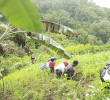CAGAYAN DE ORO CITY, Philippines – The Department of Agriculture-10 (DA-10) said last Monday that it has activated its multi-sectoral task force to address the entry of the African Swine Fever (ASF) into the country.
This after Agriculture Secretary William Dar has confirmed Monday morning that 20 samples of sick pigs in local piggeries tested positive for ASF.
Juliet Araos, chief of DA-10’s regulatory division, said the Regulatory Law Enforcement Council (RLEC) has already been put in place even before DAR’s announcement.
The RLEC is composed of DA and its concerned units such as the Bureau of Animal Industry, Health Department, Philippine National Police, local government units, and other government agencies.
Araos said the quarantine personnel are now monitoring the movement of imported meats in seaports and airports.
She said the DA has focused on disseminating information to all industry stakeholders, from the huge livestock growers down to the backyard hog raisers.
Araos has given assurance that although the ASF cannot be transferred to humans, meat from infected pigs is not fit for consumption.
In a separate interview, Dr. Katherine Mae Caterial, president of the Philippine Veterinary Medical Association (PVMA) in the region, said small hog farmers that practice “swill feeding” or those that feed their livestock with food scraps are the most vulnerable to the ASF infection as the practice helps spread the disease due to the unsanitary method of feeding.
Although there is no vaccine for the ASF, Caterial said bio-security measures can deter the ASF from spreading further.
Bio-security is a set of procedures intended to protect humans or animals against diseases or harmful biological agents.
She said measures such as disinfection of humans and vehicles in quarantine centers can help contain the virus from infecting healthy livestock.
During a recent forum on ASF held here, Jake Sepe, a quarantine officer, identified Bukidnon as the breeding for local livestock, must be protected from the virus.
Roads going to Bukidnon have at least two quarantine stations with foot bath and tire dip facilities in place for passengers and vehicles.
Sepe said that since the Philippines is an archipelagic country, there is still time to contain the ASF.
“We can still control it (from spreading) by compartmentalizing so that the ASF would not spread from island to island,” he said.
Sepe has also appealed to the riding public and motorists to cooperate by subjecting themselves to the quarantine protocol through foot bath and tire dip.
“It would be an inconvenience, but that’s the way to do it to prevent the entry of the disease,” he added.
According to the Philippine Statistics Authority (PSA) data, Northern Mindanao was the third highest in hog production, from January to March 2019, with 50.26 thousand metric tons. Central Luzon was the highest producer at 111.60 thousand metric tons, followed by Calabarzon with 92.2 metric tons.
In the following quarter (April to June), Central Luzon was still the top hog producer, at 106.00 thousand metric tons, followed by Calabarzon and Western Visayas, with stocks of 103.43 thousand metric tons and 48.82 thousand metric tons, all live weight, respectively.
As of July 2019, the total inventory of swine in the country was estimated at 12.70 million heads, the PSA said. (davaotoday.com)










